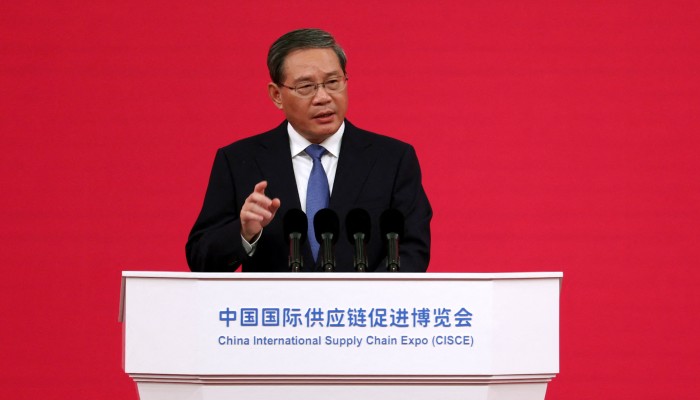The Great Decoupling: Rethinking Globalization And Supply Chains

Table of Contents
Drivers of the Great Decoupling
The Great Decoupling is not a singular event but a confluence of factors pushing businesses and nations to reconsider their reliance on globally integrated supply chains.
Geopolitical Risks and Tensions
Increased trade wars, protectionist policies, and rising geopolitical instability are major drivers of the Great Decoupling. Concerns over intellectual property theft and national security further fuel this trend.
- Increased Trade Wars and Protectionist Policies: The US-China trade war, for example, highlighted the risks of over-reliance on a single trading partner. Tariffs and trade restrictions forced businesses to explore alternative sourcing options.
- Rising Geopolitical Instability and Conflict: The war in Ukraine dramatically exposed the fragility of global supply chains, particularly for energy and essential commodities. Businesses are now prioritizing resilience over cost optimization.
- Concerns over Intellectual Property Theft and National Security: The theft of intellectual property and concerns about national security are leading governments to encourage or mandate domestic production of critical goods and technologies. This is particularly evident in the technology and defense sectors.
- Impact: Businesses are actively seeking to reduce their reliance on single-source countries and diversify their supplier bases across multiple regions. This diversification strategy aims to mitigate risks associated with political instability and trade disputes.
Pandemic-Induced Supply Chain Disruptions
The COVID-19 pandemic served as a stark reminder of the vulnerabilities inherent in globally interconnected supply chains. Lockdowns, port congestion, and transportation bottlenecks crippled global trade and exposed the fragility of "just-in-time" manufacturing.
- Lockdowns and Port Congestion: Factory closures and port congestion led to significant delays and shortages of essential goods.
- Transportation Bottlenecks: Disruptions to shipping and air freight increased transportation costs and lead times dramatically.
- Shortages of Essential Goods: The pandemic highlighted the risk of over-reliance on single sources for crucial goods, resulting in widespread shortages.
- Impact: Companies are now prioritizing supply chain resilience by diversifying their supplier bases, building safety stock, and implementing more robust risk management strategies. This includes near-shoring and regionalization.
Technological Advancements and Automation
Technological advancements, particularly in automation and 3D printing, are enabling localized production and fostering the Great Decoupling.
- Automation and Robotics: Automated manufacturing processes are making domestic production more economically viable, reducing reliance on low-cost labor in distant locations.
- 3D Printing (Additive Manufacturing): 3D printing allows for on-demand production of parts and products, reducing reliance on long and complex supply chains.
- Rise of Regionalized Value Chains and Near-Shoring: Companies are increasingly shifting production to geographically closer locations, reducing transportation costs and lead times.
- Impact: The combination of automation and advanced manufacturing technologies is empowering companies to explore on-shoring and regionalization strategies, fostering the Great Decoupling.
Implications of the Great Decoupling
The Great Decoupling has profound implications for global economics, geopolitics, and sustainability.
Restructuring Global Supply Chains
The Great Decoupling is leading to a fundamental restructuring of global supply chains.
- Increased Investment in Domestic Manufacturing and Regional Hubs: Governments are incentivizing domestic manufacturing and the development of regional production hubs.
- Development of More Resilient and Diversified Supply Chains: Companies are diversifying their sourcing and production bases to reduce reliance on single points of failure.
- Higher Production Costs in Some Sectors: Reshoring and regionalization can lead to higher production costs in some sectors, potentially impacting consumer prices.
- Impact: A shift is underway from a globally integrated model to a more regionalized and diversified approach to supply chain management.
Economic and Geopolitical Realignments
The Great Decoupling is reshaping global economic and geopolitical power dynamics.
- Potential for Increased Regional Trade Blocs and Economic Partnerships: We are seeing a rise in regional trade agreements and economic partnerships as countries seek to strengthen their economic ties within their respective regions.
- Shifting Global Power Dynamics and Competition Between Nations: The decoupling is leading to a shift in global power dynamics, with increased competition between nations for economic influence.
- New Opportunities for Emerging Economies: The diversification of supply chains presents new opportunities for emerging economies to participate in global production networks.
- Impact: The Great Decoupling is restructuring global power dynamics and leading to the emergence of new economic alliances and trade relationships.
Sustainability and Ethical Considerations
The Great Decoupling presents opportunities to improve the sustainability and ethical aspects of supply chains.
- Opportunities to Enhance Supply Chain Sustainability and Transparency: Regionalized supply chains can improve transparency and traceability, making it easier to monitor environmental and social impacts.
- Focus on Ethical Sourcing and Labor Practices: Companies are under increasing pressure to ensure ethical sourcing and fair labor practices throughout their supply chains.
- Reduced Carbon Footprint through Localized Production: Shorter transportation distances can lead to a reduced carbon footprint.
- Impact: The Great Decoupling is driving a push towards more sustainable and responsible supply chain practices.
Conclusion
The Great Decoupling is not simply a temporary phenomenon; it represents a fundamental shift in the global economic landscape. Understanding the drivers and implications of this trend is crucial for businesses and governments alike. By diversifying supply chains, investing in resilience strategies, and embracing new technologies, companies can navigate this evolving environment and secure their long-term success. To stay ahead of the curve and mitigate risks associated with global supply chain volatility, actively participate in the conversation surrounding the Great Decoupling and implement strategies for a more resilient and diversified future. Embrace the changes and rethink your approach to globalization and supply chain management in the context of the Great Decoupling. Prepare for the evolving dynamics of the Great Decoupling and build a future-proof supply chain.

Featured Posts
-
 Barys San Jyrman Msyrt Nhw Tarykh Abtal Awrwba
May 09, 2025
Barys San Jyrman Msyrt Nhw Tarykh Abtal Awrwba
May 09, 2025 -
 Palantir Stock A Deep Dive Into Q1 2024 Government And Commercial Business Performance
May 09, 2025
Palantir Stock A Deep Dive Into Q1 2024 Government And Commercial Business Performance
May 09, 2025 -
 Is Nigel Farages Reform Party A Force For Change
May 09, 2025
Is Nigel Farages Reform Party A Force For Change
May 09, 2025 -
 Franco Colapintos Deleted Drive To Survive Message What He Said
May 09, 2025
Franco Colapintos Deleted Drive To Survive Message What He Said
May 09, 2025 -
 Dogecoins Price Dip Examining The Correlation With Tesla And Elon Musks Activities
May 09, 2025
Dogecoins Price Dip Examining The Correlation With Tesla And Elon Musks Activities
May 09, 2025
